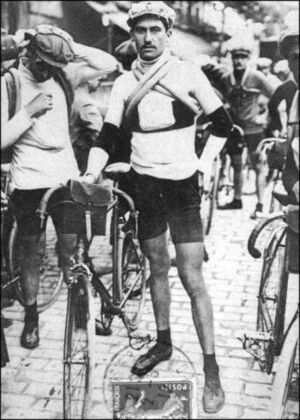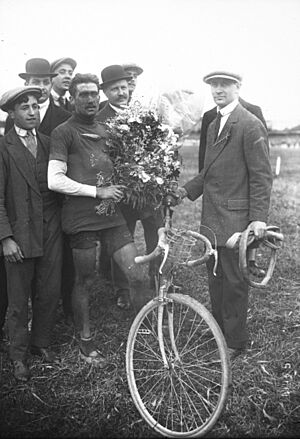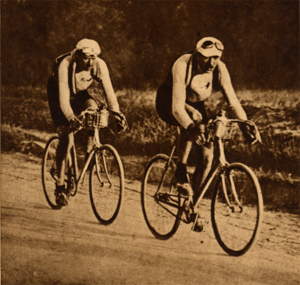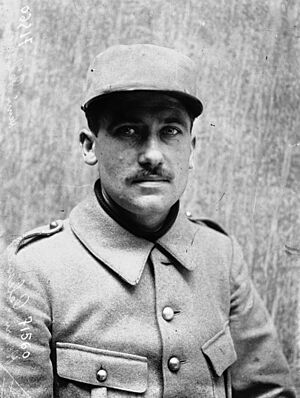Henri Pélissier facts for kids

Henri Pelissier, 1919
|
|||
| Personal information | |||
|---|---|---|---|
| Full name | Henri Pélissier | ||
| Born | 22 January 1889 Paris, France |
||
| Died | 1 May 1935 (aged 46) Dampierre, France |
||
| Team information | |||
| Discipline | Road | ||
| Role | Rider | ||
| Major wins | |||
|
|||
Henri Pélissier (22 January 1889 – 1 May 1935) was a famous French racing cyclist. He was born in Paris and won the 1923 Tour de France. Henri won 29 races in his career. He was also known for disagreeing with Henri Desgrange, who started the Tour de France. Henri Pélissier often spoke out about the tough conditions cyclists faced in the early days of the Tour.
Contents
Early Life and Career Beginnings
Henri Pélissier was one of four brothers. Three of them became professional cyclists. He started racing professionally in 1911. Before World War I, he won important races. These included the 1912 Milan–San Remo and three stages in the 1914 Tour de France.
Family Background
The Pélissier family came from the Auvergne region in central France. They were cattle farmers. Later, they moved to Paris to run a farm there.
A writer named René de Latour described the family. He said the Pélissiers came to Paris with little money. They ended up becoming very wealthy. They had a farm in Auteuil, a nice part of Paris. It was one of the last farms in the city.
Henri and his older brother had to deliver milk. They used a horse-drawn cart early in the morning. Henri didn't like this job much. He had started bike racing as an amateur. He wanted to become a professional cyclist. His father, however, did not approve of cycling as a career.
Henri Pélissier's Racing Career
Henri Pélissier first rode a bicycle when he was eleven years old. He needed a way to use up his energy. When he was 15, he entered his first race. It was a track race meant for older riders. Henri was very thin when he was young. His friends called him Ficelle, which means "string" in French. It was also the name of France's thinnest bread.
Henri was the strongest of his four brothers. Three of them became professional cyclists. He was known for being stubborn and difficult. His father even sent him away from the family farm when Henri was 16. In the next few years, Henri rode small road races. But he didn't start racing seriously until 1908 as an amateur. By 1910, he was a well-known rider. In 1911, at 22, he became a professional cyclist.
First Professional Races
On August 15, 1911, Henri met Lucien Petit-Breton near Paris. Petit-Breton was a famous cyclist. He had won the Tour de France twice. He also won Milan–San Remo. Petit-Breton asked Henri to join him for races in Italy. Henri had only six hours to decide and get ready. He met Petit-Breton for the 9 PM train to Milan.
Their first race together was the Tour of Romany-Tuscany. Henri crashed and did not finish. But he soon won Turin-Florence-Rome. He also won the Tour of Lombardy. He raced the Tour of Lombardy again the next year. He crashed near the finish line with Costante Girardengo, an Italian star. Many riders fell with them. Henri got back on his bike and passed others to win. The crowd was very angry. They thought he had ruined Girardengo's chances. They ran onto the track and tried to push and punch Henri. He had to climb into the judges' tower. He waited there for 80 policemen to calm the crowd.
Tour de France Success
Pélissier finished second in his first Tour de France in 1914. He was less than two minutes behind Philippe Thys from Belgium. Henri won three stages in that race.
After World War I, he started racing again. He won Paris–Roubaix in 1919. He also won the Circuit des Champs de Bataille in 1920. He entered the Tour de France from 1920 to 1924. Before the 1921 Paris–Roubaix, Henri and his brother Francis asked for more money from their sponsor. Their request was denied. So, they raced without team support. Henri Desgrange, the Tour de France organizer, said they would never be famous again. But Henri Pélissier won the race, proving him wrong.
In 1923, Henri won the Tour de France when he was 34. He attacked on a tough mountain climb called the Col de l'Izoard. He left behind the Belgian riders who were expected to win. He also won many other big races. These included Milan–San Remo, Paris–Brussels, Paris–Roubaix twice, three Tours of Lombardy, Bordeaux–Paris, and Paris–Tours.
Personality and Protests
Henri Pélissier was often in arguments. He disagreed with race organizers, sponsors, and the media. Henri Desgrange, the Tour organizer, called him "this pigheadedly arrogant champion." When Henri trained, he told his friends to take it easy. He said, "It's important not to wear yourself out." But he secretly trained hard early in the morning.
He often made fun of his rivals. During the Tour de France, he once said, "The others are cart horses; I'm a thoroughbred." The next day, Henri got a flat tire. All the other riders left him and his brother Francis 30 minutes behind.
Henri argued with Desgrange many times. In 1920, Desgrange fined Pélissier two minutes. This was because Henri left a flat tire by the roadside. Pélissier quit the race in protest. He then made sure to win every other race for the rest of the season. Desgrange joked, "Pélissier can win any race except the Tour."
His arguments and quitting races made the public interested. But it made everyone else angry.
Oscar Egg, another cyclist, said Henri was an amazing rider. He had a natural talent for racing. But he also said Henri needed to control his reactions better. If he had, he would have been an even greater champion.
Fighting for Riders' Rights
Pélissier saw himself as a champion for cyclists. He felt they were paid very little by their sponsors. He fought against Desgrange's rule that riders in the Tour de France should have limited food. Pélissier also disliked other small rules. In 1919, he quit the Tour. This was because Desgrange would not let him have an extra glass of wine after a stage. He quit again in 1920 because of bad weather.
Henri Pélissier tried to start a cyclists' union. But it did not get much support. Only riders close to him joined. Other French riders and most foreign riders stayed away. They were not sure they wanted to be led by someone who argued so much.
The Convicts of the Road
In 1924, Henri, his brother Francis, and another rider named Maurice Ville quit the Tour. This happened after Desgrange would not let Pélissier take off a jersey as the sun came up. A journalist named Albert Londres met them. He wrote about their conversation. His article was called Les Forçats de la Route, which means "The Convicts of the Road."
Henri explained that the argument was about jerseys. A race official had checked if he was wearing two jerseys. Henri felt this was rude. He said riders should be able to wear as many jerseys as they want. He also said they couldn't throw away anything given by the race organizers. But Henri said his jersey was his own. He quit because he felt he was not being treated fairly.
Henri told his brother Francis to quit too. Francis agreed, saying he felt unwell. Ville also said he was too tired to continue.
Henri described the Tour de France as a "calvary." He said it was like a very hard journey. He explained how much they suffered on the road. He mentioned how dirty they got and how tired they were. He said they couldn't sleep well at night. He felt they were treated worse than mules. He complained that officials checked everything, even if they put a newspaper under their jersey for warmth.
Albert Londres got a great story. Francis later said they might have made some things sound worse than they were.
Retirement and Later Life
Pélissier rode his last Tour de France in 1925. He did not finish that race. He stopped racing completely in 1927. For two years after his career, he did nothing. Then, he became a motorcycle-pacer and a team manager. He did not have much success in these roles. In 1932, he wrote about his thoughts on the Tour de France for a newspaper. He remained upset about how cyclists were treated.
Death
Henri Pélissier's first wife, Léonie, passed away in 1933. Henri Pélissier himself died on May 1, 1935.
Memorial
Fans at the Parc des Princes stadium bought a special memorial. It was a bas-relief artwork for Henri, Francis, and Charles Pélissier. It was placed at the velodrome, a cycling track. When the Parc des Princes was torn down, the memorial was moved. It is now at the Piste Municipale.
Career achievements
Major results
- 1911
- 1st, Giro di Lombardia
- 1st, Milano–Torino
- 1912
- 1st, Milan–San Remo
- 1913
- 1st, Giro di Lombardia
- 2nd, Overall, Tour de France (and Stages 10 and 12)
- 1919
- 1st, Paris–Roubaix
- 1st, Bordeaux–Paris
- Stages 2 and 3, Tour de France
- 1920
- 1st, Giro di Lombardia
- 1st, Paris–Brussels
- Stages 3 and 4, Tour de France
- 1st, Circuit des Champs de Bataille (single day race)
- 1921
- 1st, Paris–Roubaix
- 1922
- 1st, Paris–Tours
- 1923
 1st, Overall, Tour de France (and Stages 3, 10 and 11)
1st, Overall, Tour de France (and Stages 3, 10 and 11)- 1924
- 1st, Overall, Tour of the Basque Country
Grand Tour results timeline
| 1912 | 1913 | 1914 | 1915 | 1916 | 1917 | 1918 | 1919 | 1920 | 1921 | 1922 | 1923 | 1924 | 1925 | |
|---|---|---|---|---|---|---|---|---|---|---|---|---|---|---|
| Giro d'Italia | DNE | DNE | DNE | N/A | N/A | N/A | N/A | DNE | DNE | DNE | DNE | DNE | DNE | DNE |
| Stages won | — | — | — | — | — | — | — | — | — | — | ||||
| Tour de France | DNF-4 | DNF-6 | 2 | N/A | N/A | N/A | N/A | DNF-5 | DNF-5 | DNE | DNE | 1 | DNF-3 | DNF-4 |
| Stages won | 0 | 1 | 3 | 1 | 2 | — | — | 3 | 0 | 0 | ||||
| Vuelta a España | N/A | N/A | N/A | N/A | N/A | N/A | N/A | N/A | N/A | N/A | N/A | N/A | N/A | N/A |
| Stages won |
| 1 | Winner |
| 2–3 | Top three-finish |
| 4–10 | Top ten-finish |
| 11– | Other finish |
| DNE | Did Not Enter |
| DNF-x | Did Not Finish (retired on stage x) |
| DNS-x | Did Not Start (no started on stage x) |
| HD | Finished outside time limit (occurred on stage x) |
| DSQ | Disqualified |
| N/A | Race/classification not held |
| NR | Not Ranked in this classification |
See also
 In Spanish: Henri Pélissier para niños
In Spanish: Henri Pélissier para niños




